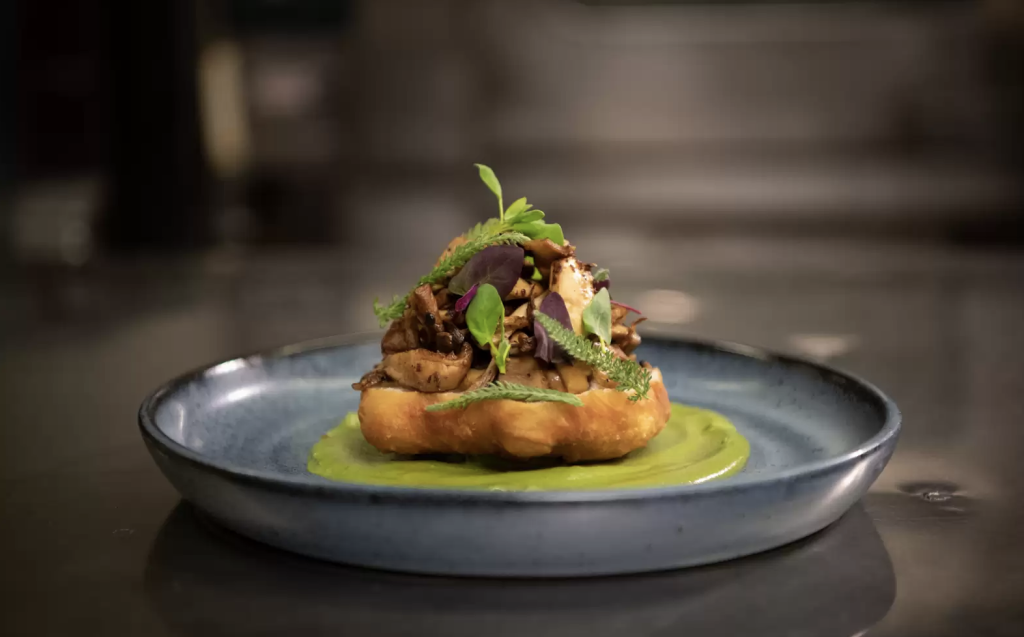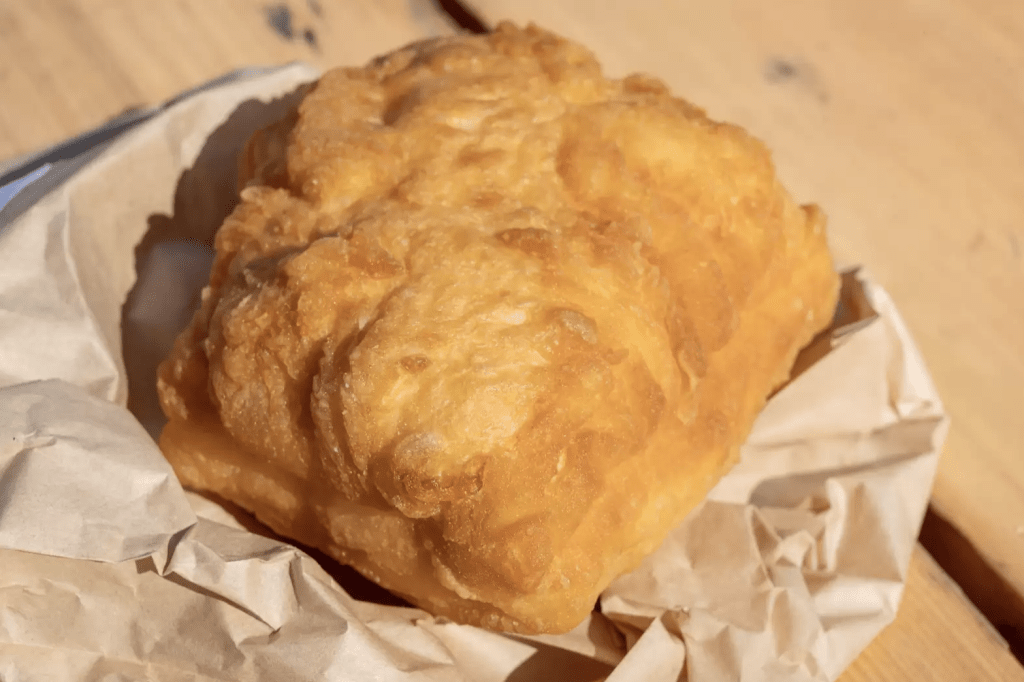Staple breads help local chefs get closer to food sovereignty.

In British Columbia, indigenous knowledge is passed on through a warm basket of bannock. Bread, also known as the “Aboriginal staff of life,” is a link to the past, a staple food of nations that existed long ago. But it still has a place at the table, indigenous or otherwise, as a comfort food that knows no boundaries.
Bannock can be many things. Pillow-shaped dough – a simple mixture of flour, water, baking powder and salt – can be baked, fried or cooked over an open fire. Depending on how you prepare it, the bread can be crunchy like a scone next to an array of jams, served as a little round bun for a wild salmon burger, or with a little oil in the form of a doughnut.
Inez Cook, founder of Salmon n’ Bannock, Vancouver’s only First Nations-run restaurant, remembers making bannock at summer camp – the place where many British Columbians were first introduced to bread.
“Sometimes I swear I got cheated out of my summer camp bannock, probably Bisquick,” Cook jokes. “But I have fond memories of putting it on the fire and putting corn syrup on it.” Although Cook knows it’s a native bread, it’s not something she eats at home.
Cook was born in Nuxalk, but grew up white. When she was only a year old, she was taken from her mother during the Sixties Scoop, a government policy of cultural assimilation that began in the 1950s and continued into the 1980s. It involved forcibly removing Indigenous children from their families and placing them with non-Indigenous families across Canada.
Years later, while driving past the Aboriginal-owned Kekuli Café in Kelowna, she saw a sign that read, “Don’t panic …… we have Bannock!” which is the restaurant’s signature motto. “It brought me right back,” she says. Cook’s reconnection with her culture is ongoing, and she continues to learn about indigenous food every day at Salmon n’ Bannock.
The restaurant’s signature Bannock is served in a variety of ways: cookies, salmon mousse; or topped with sautéed mushrooms, melted brie, sage blueberries and bison gravy. “All the indigenous people in the world have made some kind of bread, pre-contact,” she explains. “I want it in our name because it communicates directly to the indigenous people that this is your place.”
What is the history of Bannock?
Selkirk, a Scottish fur trader, is said to have introduced a bannock made from oats to the native peoples of North America in the 18th and 19th centuries. These communities adapted the recipe, replacing oats with corn and nut meal and flour made from ground plant bulbs.
But in recent years, researchers have revealed that the indigenous people had their own pre-colonial version of bannock. “Apparently, carbohydrate-rich foods like wheat did not exist here. Pre-contact, it’s not something we really cultivate,” says Valerie Segrest, a member of the Muckleshoot Indian Tribe and a native nutrition educator specializing in Northwest Coast foods.
“But some of the bread is extracted from the bark of trees like birch or alder,” she adds. “It’s a very laborious practice where you harvest the bark, mash it forever and then basically turn it into a powder. There may be other plants added, like balsam pollen, and the dough is baked in the sand.” This is called an earthen oven, in which you would build a fire, dig a small hole nearby, and then put the dough near the fire and let it bake in the dirt.
Bannock is associated with fry bread, a food more commonly found in Native American communities. Named the official bread of South Dakota, fry bread was made by government rationing and given to Navajo citizens after they were forced to move from Arizona to New Mexico in 1864. Generally speaking, bannock is a rising bread, while fry bread is more or less a meatloaf – sometimes made with yeast – fried on both sides.
“I think it’s a culinary innovation to take these ingredients and components and turn them into something that resembles traditional food,” Segrest added. “That’s why I think fry bread is so revered. It’s similar to what we call bark bread, which became bannock bread, which eventually became fry bread. That feeds people in times of hunger.”

Bannock’s history over the years
Quaaout Lodge and Spa is located on the shores of Little Shuswap Lake, in the Secwepemc Territory. bannock has always been part of the hotel’s locally styled Jack Sam’s restaurant dining service. It appears on eggs Benedict as an alternative to English muffins or in panzanella salads in place of stale bread.
“When people think of bannock, they don’t think, ‘Oh, the settlers brought it to us,'” says Tristan Jules, chef at Quaaout Lodge and Spa. “No, we took that concept and made it our own. Go to any pow wow in North America and I can guarantee you’ll get bannock, fry bread or some variation of both.”
Jules grew up attending the annual bannock tournament held in the Shuswap area. All the communities would get together and have bannock cook-offs to see who ate the best in the area,” he says, “and they would serve everything from bannock hot dogs to bannock fritters.
Each region has its own way of making bannock, and the version Jules is familiar with involves a starchy fruit that is crushed, dried in the sun, and turned into dough. In the restaurant, he chooses to make bannock with lard. “It gives it a better flavor than any other oil I’ve tasted so far,” he says. “But it also depends on what you put in the bannock. Some people even add various sweeteners, such as sugar or honey, before they put it in the fryer.”
Some recipes try healthier renditions, and Segrest has worked with tribal communities in the Northwest to integrate a resource called “Feeding People, Feeding Spirit. Although the book is now out of print, it features Bannock recipes with more plant-based ingredients, “like the traditional hazelnut flour here, or nettle leaf flour for added nutrient density,” she says.
Many First Nations people don’t have access to nutritious food because of economic barriers and environmental issues (which is why Cook doesn’t serve Coca-Cola at her restaurant). “It could be environmental toxins in the food, climate change, lack of access to grocery stores or harvesting safe areas,” Segrest explains. “The lack of knowledge due to our country’s colonization and federal policies has led to a serious disruption in the spread of cultural food knowledge from one generation to the next.”
But Segrest believes Bannock still has a role to play in healthy meal planning. “I really try not to play the slanderous food game that many nutritionists are known to play,” she says. By substituting refined white flour or adding more natural ingredients, Segrest insists that people can still enjoy the foods that shaped their culture.
Bannock can play a role in food sovereignty
Food sovereignty is particularly important to Segrest, who defines it as “the inherent right of a person to define and shape their diet. Through the Muckleshoot Food Sovereignty Project, she works to increase access to traditional foods in communities, including educational programs on harvesting, hunting and fishing.
Salmon n’ Bannock’s Cook believes we still have a long way to go in achieving food sovereignty for indigenous communities. Certain foods, such as game, must go through a series of regulations before they can appear on the menu.
“In Canada, there are over 600 of them. In B.C. alone, there are more than 200 countries. Our culture is very, very rich, and we’re not allowed to serve traditional foods,” she explains. “What the health inspectors need to do to approve us to serve these foods is that all communities need to have commercially approved kitchens.”
She continued, “Imagine this. There is only one Japanese restaurant in all of Tokyo. There’s only one. And they’re not allowed to serve food. What would happen?” While there’s still a lot of work to be done, Breaking Bannock could be a step toward preserving indigenous culture.
As Cooke says, “I like to think of it as celebrating the here and now.”
